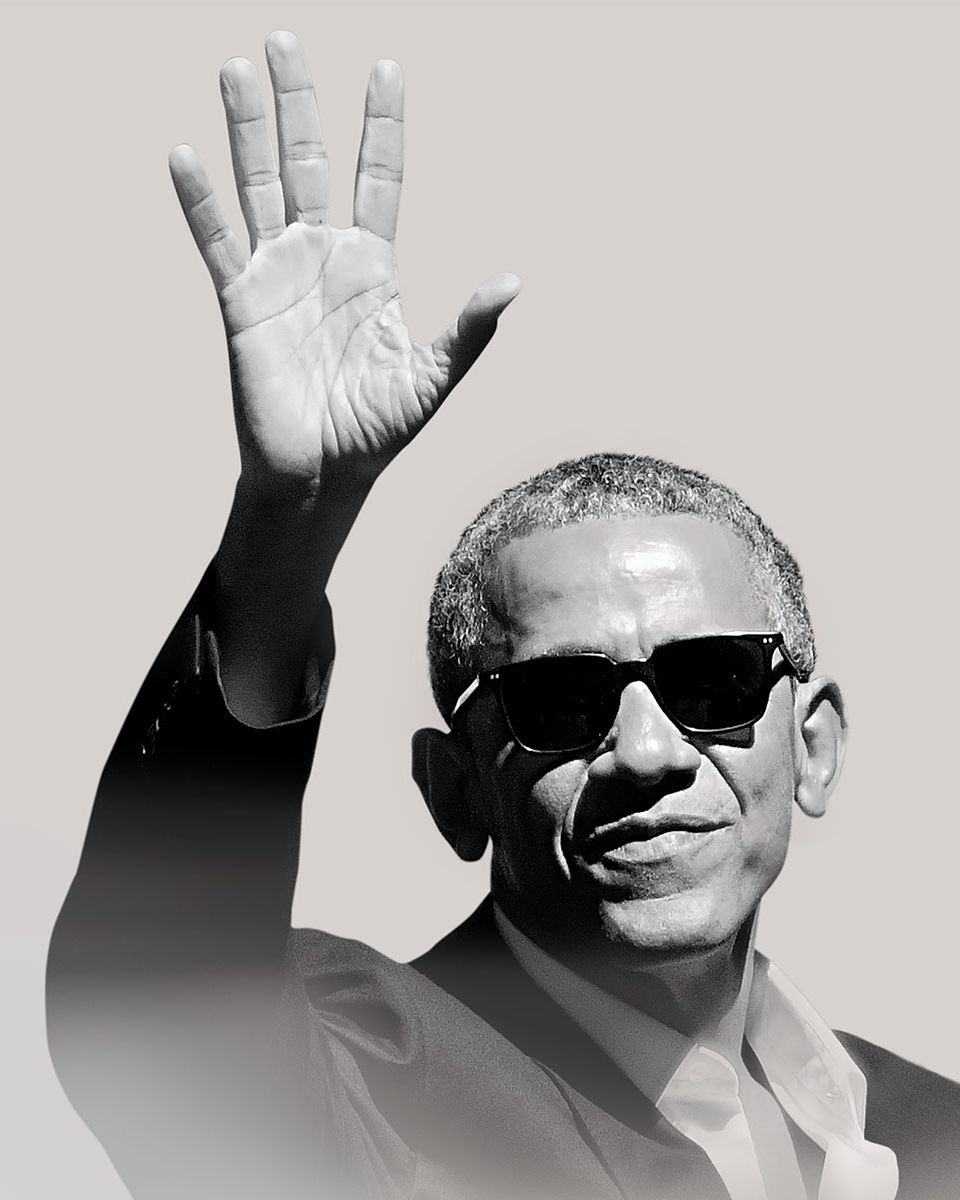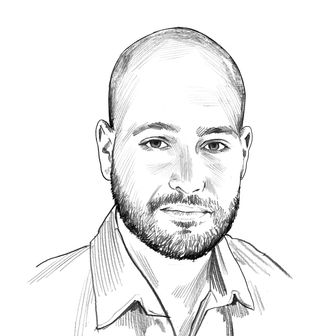Barack Obama was six months into his post–White House life when Donald Trump found a new way to grab his attention. It was a Tuesday morning deep in the mid-Atlantic summer, and, feeling a world away from the Pennsylvania Avenue grind, the former president was reading the New York Times on his iPad.
The previous evening, Trump had visited West Virginia, where he spoke at the annual Boy Scout Jamboree. Addressing a crowd of roughly 40,000, who were expecting the usual talk about citizenship and service, the president uncorked a political diatribe packed with jabs at Obama, Hillary Clinton, and the Washington, D.C., “cesspool”; reminders about the importance of saying “Merry Christmas”; and reminiscences of Election Night 2016 and the pundits he embarrassed. “You remember that incredible night with the maps, and the Republicans are red and the Democrats are blue, and that map was so red it was unbelievable. And they didn’t know what to say,” Trump told the Scouts. They seemed bewildered at first but before long broke into chants of “USA!” Adult observers were openly horrified. Three days later, the Boy Scouts’ leader would apologize for Trump’s speech.
In Washington, where the former president still works and lives with his wife, Michelle, and his younger daughter, Sasha, Obama stewed. Ever since the shocking election, he had resisted condemning his successor directly. Early on, he would muse to senior aides in private about what it meant that the country had chosen Trump, bouncing between writing off the election as a freak accident and considering it a rejection of his own vision of America. In the months after the inauguration, Obama referred publicly to the new president only sparingly — but still more than he expected to. He issued careful statements defending the Affordable Care Act and supporting the Paris climate-change agreement, avoided mentioning Trump by name, and largely let the resistance speak for itself. But the Boy Scouts speech really troubled him. Kids their age are the most impressionable group there is, Obama reminded friends at the time, likening them to sponges. If the president shoves a divisive political argument at them, that’s what they will absorb.
It was a very Barack Obama thing to get agitated about. Throughout his entire political career, he has attached an unusual degree of significance to storytelling, and he has often spoken of the importance of modeling what it means to be a good citizen. He had recently concluded a two-month stretch full of international travel and was just starting to settle into his post-presidency, and that week was a busy one in Washington — Republicans were zeroing in on a vote to repeal the Affordable Care Act. The Boy Scouts speech was relatively unimportant (mostly improvised, probably something Trump would forget about within a week), but perhaps it presented an opportunity. One of the most potent tools in Obama’s arsenal, as a retired president, is rhetoric. Even if he no longer enjoyed the bully pulpit, he could, if he wanted, fill the vacuum of moral leadership Trump had created and offer, to not only the Scouts but the entire country, a lesson in civics that no other Democrat is positioned to give.
But then he did another very Barack Obama thing: He decided to stay quiet.
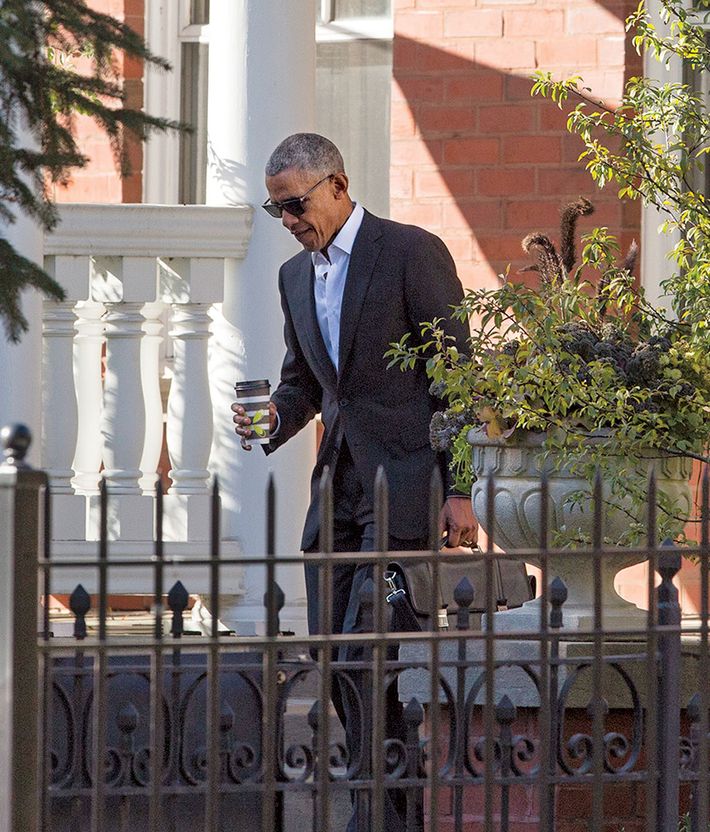
Where is Obama? It is a question much of the country has been asking over the last two years, sometimes plaintively. “Come back, Barack,” Chance the Rapper sang in a Saturday Night Live sketch. “We all miss him,” Kobe Bryant said, speaking for other athletes. Even former FBI director James Comey admitted to German interviewers this spring that he misses Obama.
Beyond the anguish is, often, simply bafflement: How did the most ubiquitous man in America for eight years virtually disappear? Over the course of his presidency, Obama cast himself as the country’s secular minister as much as its commander-in-chief, someone who understood the moral core of the nation and felt compelled to insist that we live up to it. What explains his near absence from the political stage, where he might argue publicly against the reversals of his policy accomplishments, and also from American life more broadly? What is keeping him from speaking more frequently about the need to protect democratic norms and the rule of law, to be decent people? Where is the man who cried after Sandy Hook and sang in Charleston, who after each mass shooting tried to soothe an outraged nation, who spoke of American values in his travels across the globe? And, tactically, what is behind the relative silence of one of the most popular figures alive just as American politics appears to so many to be on the brink of breaking?
Earlier this month, weeks after news first came out of thousands of immigrant children being held apart from their parents at the border, and after Laura Bush had published an article excoriating her party’s policy, Obama and his team chose to make a rare foray into the news cycle. First, they decided that Michelle should take the lead, and she did so by retweeting Bush’s article approvingly (“Sometimes truth transcends party”). That received a further retweet from Barack, in a bid to keep the conversation about families rather than about politics — as he calculated it would have been had he weighed in directly. Two days later, with the crisis dominating the national news, Obama’s advisers saw an opportunity in World Refugee Day to issue a statement of his own that focused on American values rather than Trump-administration policy. It was an eloquent call for empathy. It was also, to Democrats desperate for him to break post-presidential precedent, the very least he could have done.
Obama’s reticence is more than simply a matter of communications strategy. He has mostly opted out of liberal America’s collective Trump-outrage cycle. Though he reads the Times and other newspapers, he doesn’t follow daily Trump developments on Twitter or watch television news. He is upset by the administration’s actions, and he’s confided to friends that what worries him most is the international order, the standing of the office of the presidency, the erosion of democratic norms, and the struggles of people who are suddenly unsure of their immigration status or the future of their health-care coverage. Still, in conversations with political allies, Obama insists that today’s domestic mess is a blip on the long arc of history and argues that his own work must be focused on progress over time — specifically on empowering a new generation of leaders. He says his legacy is not what concerns him. (“Michelle and I are fine,” he tells those who ask about it.) And while he often says he misses the day-to-day work of fixing people’s problems, he has even less patience for day-to-day politics than he did as president.
In fact, in private conversations, Obama rarely mentions Trump at all. Those who’ve visited the office he’s leased from the World Wildlife Fund in Washington’s West End say he’s eager to talk for hours about the world’s ills. When informed about the latest presidential tweetstorms aimed at him, he chuckles and changes the subject. One friend of Obama’s recalled that after a 45-minute meeting that avoided the subject of Trump entirely, the pair ducked into an aide’s office and saw on television that the president was claiming to have been absolved in the Russia inquiry. Obama’s eyes flicked toward the chyron and his face took on a decidedly bemused aspect for a beat before he turned back to their conversation as if nothing had happened.
“The important thing to think about with Obama in the context of politics is what his overall goals are,” says Jim Messina, his 2012 presidential-campaign manager and informal adviser. Obama’s first goal is to adhere to the precedent George W. Bush set, leaving him alone and respecting the peaceful transfer of power. The second is to engage a younger generation of leaders. “And then, three, how to carefully decide when you have to sacrifice one and two, especially one. He has been really careful about No. 1,” Messina says. “He could pick a fight with Donald Trump every day, and (a) the only winner would be Donald Trump, and (b) we would kind of get into this back-and-forth the Clintons have gotten themselves into: Is there too much Obama? Not enough Obama?”
One of Obama’s friends repeatedly described the former president as newly “Zen-like,” a striking descriptor given that Obama’s impossible calm has been a hallmark of his entire time on the national stage. To those who’ve known him longest, his confidence in the decision not to wade back into the political muck is the product of the same hyper-self-aware posture he’s had since childhood, growing up straddling worlds and then writing a book about himself in his 30s. “This has been a difficult thing for him, and for me, to see what this administration has done to the policy initiatives that we put in place and that were proving to be successful,” says Eric Holder, Obama’s friend and former attorney general. “But I think it’s really been true — we’ve had conversations about this — he’s been encouraged by the amount of progressive energy he’s seen around the country.”
To Obama, the Women’s Marches and the wave of gun-control activism after the Parkland school shooting are more influential than anything he might do to alter the news cycle, especially since his presence as a Trump counterweight often consolidates the otherwise fractured GOP base. “Even when we were in the White House, he wasn’t interested in discussing the day-to-day of politics, whether it was Speaker Boehner or Speaker Ryan or Leader McConnell, or whatever was the news of the day,” says Valerie Jarrett, one of Obama’s closest advisers. “Wasting time on things he can’t control is not of interest to him. Getting sucked into a conversation over someone who he has no ability to influence? What’s the point?”
Of all his political gifts and tools, Obama has always been most hesitant to wield raw power, circumscribing the options available to him by dismissing the bluntest tools as either immediately or eventually counterproductive. If one philosophy governed his political activity in the final stretch of his presidency, it was articulated by Michelle at the 2016 convention: “When they go low, we go high.” Built into that code of conduct is his famous long-term optimism about historic progress as well as a confidence that his empathetic approach to governing will ultimately be more successful than dishonest tactics or mean-spirited politics.
But there was always a flip side to both of these assumptions: alongside the optimism, a fatalism about human nature and political incentives, and alongside the confidence, a streak of resignation, a sense that he alone can only do so much. Throughout Obama’s administration — even before, during the 2008 campaign — liberals agonized over his temperament, afraid that he was squandering opportunities or bringing knives to gunfights. As he finished his second term, Obama took a victory lap, and it was easy to believe that he’d been right all along. Then came the Trump era — and with it, a greater test of Obama’s philosophy than he ever imagined it facing.
And yet, for all of the new president’s radical transformation of the nation, he’s done little to alter the character of his predecessor, or reshape Obama’s vision of the world. Obama believes more than ever in his capacity to spark an immediate backlash among Trump fans and to make any policy matter far more partisan. The calls from former staffers and allies who want him in the field, actively protecting his policy legacy — whether it’s through speeches, organizing, or lobbying — are considered but mostly brushed aside. “I know it isn’t usually done that former presidents weigh in, but these are not usual times, and protocol seems to have vanished,” says Susie Tompkins Buell, a major Democratic donor. “On the immigration stuff, if he were willing to go way over the line and get arrested, or something way out there, that would be a galvanizing event,” says one frustrated leading Democratic operative in the midst of the 2018 campaigns.
Even quotidian political activity would be welcomed by many — after all, about two-thirds of the country now approve of his presidency. “People continue to want, to ask for, his intervention — and even be frustrated when they don’t get it,” says Jennifer Palmieri, Obama’s communications director during part of his second term. “But they will be, ultimately, wrong to feel that way. Because what they want is for Barack Obama to be president, and he is not. They miss Dad, and they’re homesick, and there’s so much in the world that’s disorienting, and they want something that they love and that’s familiar. And he can never be what people ultimately want. There’s no outcome here where everyone says, ‘I miss Barack Obama, but I understand what he’s doing and I understand the choices that he’s making.’ ”
Modeling his political engagement out of office after George W. Bush’s, of all people — privileging the customs and traditions of our democracy rather than upending some in order to fight for others — may be among the most optimistic choices Obama has ever made. Perhaps an America that survives Trump will appreciate that his predecessor did not stoop to his level. But Obama’s disciplined restraint could also prove a poorly timed abdication of leadership. “The reason this is different than other post-presidencies,” says Princeton political historian Julian Zelizer, “is this is kind of a crisis in governance.”
The people around Obama are living in Trump’s America, too, they remind skeptics of his approach. They’re just wagering that the former president’s bet pays off. “He’s recognizing that the party and our country will benefit from other voices having an opportunity to weigh in, and that opportunity would be all but completely obscured if he were regularly sharing his opinion on these issues,” says Josh Earnest, who joined Obama in the early days of his first presidential run and who finished the administration as Obama’s last White House press secretary. “It is far too early to tell whether that works.”
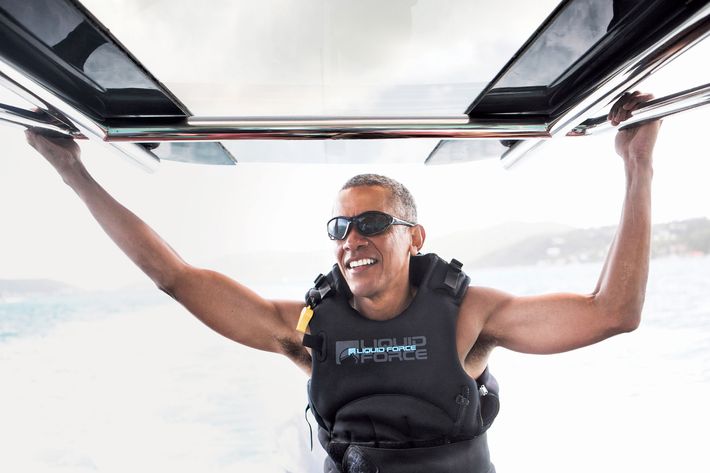
Not since Harry Truman’s icy handover to Dwight Eisenhower has the country experienced anything close to the distance between the outgoing and incoming president as there is now between Obama and Trump. There’s been no direct contact between the two since Inauguration Day.
While Trump expressed openness to Obama’s guidance when they first met in November 2016, that fizzled almost immediately as the new president and his allies became obsessed with the idea that Obama and his holdovers were trying to undermine them. Trump even accused Obama of wiretapping him, against all evidence. The hard turn against Obama was probably inevitable from a man whose rise to political prominence was fueled by a conspiracy theory about Obama’s birth certificate. But it’s been cemented by the administration’s systematic attempt to bludgeon every one of Obama’s biggest moves, from strangling DACA and the Trans-Pacific Partnership trade agreement to enacting regulatory rollbacks through the Environmental Protection Agency administrator, Scott Pruitt, and Attorney General Jeff Sessions.
Obama is monitoring the destruction, but he spends the bulk of his time on two projects, building his foundation and writing a memoir. It’s a familiar vision for a post-presidency and, for now, a return to two activities with which Obama is temperamentally more comfortable than raw politics: organizing and writing.
The Obama Foundation is designed to be a grand, global convening zone for younger generations of leaders, physically on its Chicago campus but also through international programming and an ambitious online presence. Already this year, it has launched an academic program with the University of Chicago, a hyperselective global fellowship for “civic innovators,” and a community program designed to support and train 300 young leaders in Phoenix, Chicago, and Columbia, South Carolina. The presidential center and museum in Chicago’s Jackson Park, scheduled to open in 2021, is being designed with the idea of giving visitors resources to change the politics around them. “It’s not a mausoleum; it’s not a retrospective-looking entity,” says David Simas, the foundation’s CEO and former White House political director. “The entire experience is being structured in a way where the success is when someone leaves there and wants to not only engage in their community — but we help them tie back into the network that we’re trying to create.” In Washington, Obama frequently meets with the architects of the space. Much of the ambition behind the foundation comes from the assumption that, at 56, he will be fueling its growth for decades.
Obama has been raising money to get the organization on its feet. Multiple people familiar with the fund-raising conversations said it’s currently aiming to bring in between $500 million and $1 billion, and that when Obama meets with major potential donors, his asks can sometimes reach $10 million or $20 million. The foundation has periodically disclosed its donors, categorizing them in broad tiers. Organizations and individuals who have given at least $1 million include major institutions like the Gates Foundation; Democratic heavyweights like Bob Iger, Marc Benioff, and J. J. Abrams; and even Chicago hedge-fund manager Ken Griffin, a prominent Republican donor.
Obama has given well over a dozen paid speeches, earning at least $300,000 for each, sometimes far more, including ones to financial institutions like Carlyle, Cantor Fitzgerald, and Northern Trust. By mid-July, he will have visited every continent but Antarctica since leaving office. At each stop, from New Zealand to Italy, he’s met with local heads of state or allied former leaders, almost always in private. He’s been careful not to appear to be playing at international diplomacy, but people close to him believe his presence is often intended as a reassurance that the world isn’t about to end. Appearing in public with German chancellor Angela Merkel in Berlin in May 2017, he declared, “We can’t hide behind a wall.” In Milan, he sat with former prime minister Matteo Renzi and talked about the populist Five Star movement and Russian election meddling in Italy. In Buenos Aires, he golfed with President Mauricio Macri, who was facing his own populist challenges. In Montreal, he joined Prime Minister Justin Trudeau for a well-publicized dinner over Hinterland wine and local halibut.
And as he travels the world for speeches and vacations, Obama has included on his itinerary meetings to gather ideas for the foundation from civically engaged young people in India, Indonesia, and Brazil. In October in Chicago, the foundation held its first summit, bringing local civic entrepreneurs together with celebrities including Chance the Rapper, Lin-Manuel Miranda, and Prince Harry. In July in Johannesburg, he will convene 200 young leaders from across Africa.
But meanwhile his book looms. While Michelle’s will be published in November, no title or date has yet been announced for his part of the reported $65 million deal the couple signed with Penguin Random House last year. No one close to Obama expects the finished product to look anything like other White House memoirs, given his history as a writer. “He is engaged in reflection, and he also cares about writing,” says Tim Kaine, the Virginia senator and an Obama friend. “I would be surprised if it’s just a standard chronological accounting of his last eight years.”
Large swaths of Obama’s days are now carved out for writing. Yet friends who’ve spoken with him about the process say Obama, who is working closely with speechwriter Cody Keenan and other aides, is still thinking through the central thrust of the book, which he’s been scrawling out, longhand, on yellow legal pads at his desk. People around Obama tend to sigh when asked about his progress — more than one said, “Well, you know, he works best under pressure.”
Occasionally restless, he has taken to bringing in friends to chat during what his aides call “desk time,” both to break up the monotony and to ask for memories of the administration. Kaine said that once, last year, Obama asked him to come over and talk when he was clearly supposed to be writing. Their 30-minute appointment bled toward an hour.
Usually, these catch-ups touch on ongoing issues. Sometimes, he’s offering advice. Eric Lesser, a 33-year-old Massachusetts state senator who worked for Obama’s 2008 campaign and then at the White House, met with him this spring to talk through his work and legislative frustrations. (“It’s like talking about peewee-football practice with Tom Brady,” says Lesser. “Like: ‘I can’t throw a spiral, Tom! Help!’ He was amused I was coming to him with that.”)
Most of those meetings take place in Obama’s polished office, which he shares with Michelle, their chiefs of staff, and roughly 20 staffers. The walls are decorated with memorabilia, including a framed American flag presented to Obama by the Navy seals who killed Osama bin Laden; Norman Rockwell’s painting of Ruby Bridges, signed by Ruby Bridges; and a photograph of one of Obama’s ancestors that was presented to him by the Irish government.
The Obamas appear to be settled in Washington. The chatter about their potential move to the Upper East Side has died out, and they are installing a pool at their home, which is around the corner from Jared Kushner and Ivanka Trump’s. Obama is open with friends about the new comforts of his life: the games of Words With Friends on his iPad, the rounds of golf, the slower-paced international travel. Immediately after leaving office, he flew to Palm Springs, then visited with Richard Branson on his private Caribbean island. Before long, he was on David Geffen’s yacht in French Polynesia with Tom Hanks, Bruce Springsteen, and Oprah Winfrey.
Even in Washington, he’s taken to undoing an extra button on his dress shirts and musing about how much more sleep he now gets. When he lets his guard down, he admits that he misses being in the middle of the international fray, but he confides that his life has slowed down so dramatically that he now feels like Neo, Keanu Reeves’s character in The Matrix, who can experience time hyperslowly while facing gunfire.
Over the next few years, his main source of income aside from the book is likely to be the deal he and Michelle signed in May with Netflix, which, he has told friends, he sees as a more palatable way to make money than the paid-speech circuit. That arrangement, long under discussion, came about in large part because of the years-long relationship between Obama and both Reed Hastings, Netflix’s CEO, and Ted Sarandos, its chief content officer. Sarandos, then a Hillary Clinton backer, met his wife, Nicole Avant, at an Obama fund-raiser in 2008 that she was co-hosting. Avant became Obama’s ambassador to the Bahamas. The connections between Obama and Netflix go deep: Sarandos’s new chief of staff is Ferial Govashiri, who served as Obama’s personal assistant in the White House.
After leaving office, the Obamas were open about their interest in creating content and aware of the positive reaction they received to their recommended book lists and playlists during the White House days, say people familiar with the discussions. They landed on a conceptual agreement with Netflix to create a wide range of programming that will likely be free of politics, light on their own faces, and heavy on telling the stories of individuals who the Obamas believe can guide viewers to be better citizens. When Netflix announced the deal, the Obamas also disclosed that they were launching “Higher Ground Productions” to create the shows. That studio, and team, does not yet exist, and few of the details have been set. No one involved in the project expects any programming to see the light of day until late 2019 or 2020.
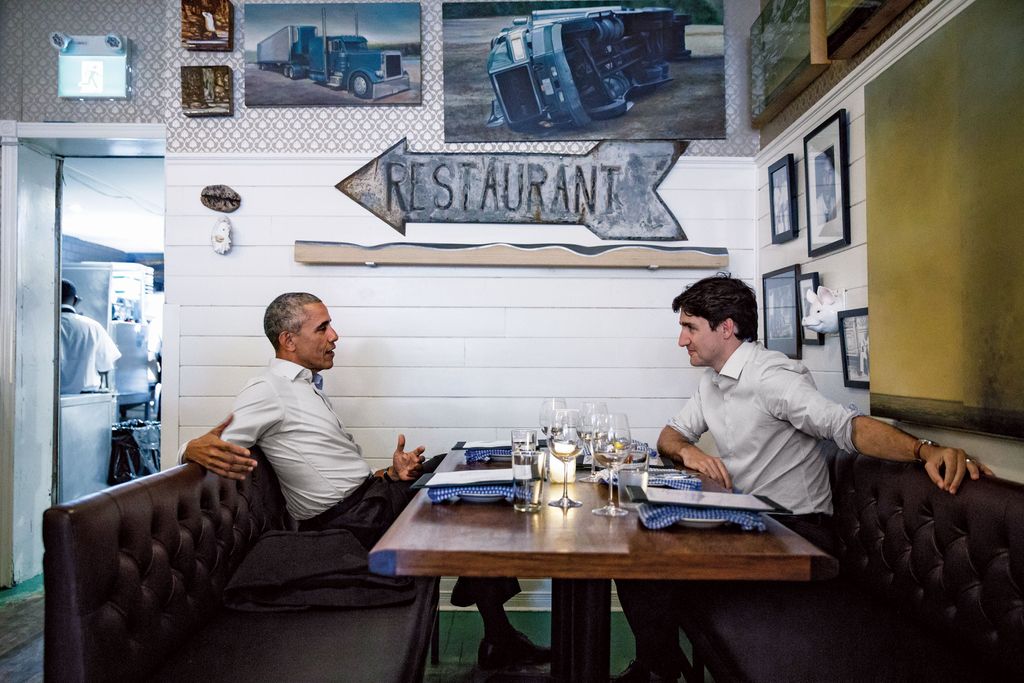
Despite not wanting to engage directly in Washington politics, Obama has played a significant behind-the-scenes role in one battle: saving Obamacare from Republicans intent on destroying it. Even before leaving office, he signaled to party leaders that he didn’t see how having his face at the forefront of the fight could be useful. “It’s pretty clear what President Trump’s political strategy always is, which is to find a foil,” says Earnest. “And with the possible exception of Hillary Clinton, his most prominent foil has been Barack Obama. That’s been a very effective strategy for President Trump to galvanize his base and effectively put Republicans on Capitol Hill in the fetal position.”
So Obama receded while organizations founded and run by his administration’s alumni sprang up to lean on lawmakers and lead a public-facing campaign to generate support. By mid-2017, the groups were running a war room and hosting regular conference calls. Obama followed at a distance, weighing requests for his input and support and discussing tactics with leaders of the campaign. Senator Bernie Sanders, a longtime skeptic of the ACA who instead favors a Medicare-for-all system, became an outward face of the effort, holding rallies in states where Democrats were trying to peel away GOP support.
Trump’s war against Obamacare intensified, and after a failed effort to gut the law in the spring, a summer vote in Congress began to look more likely to succeed. Obama resisted holding rallies of his own, worried about dissuading on-the-fence Republicans from breaking party lines, but in May he agreed to ratchet up the pressure. He slipped a newsworthy bit into his speech at the John F. Kennedy Profile in Courage Award celebration in Boston: “I hope that current members of Congress recall that it actually doesn’t take a lot of courage to aid those who are already powerful, already comfortable, already influential.”
The next month, as the ACA’s survival prospects looked ever more grim, Obama offered a statement on Facebook condemning the GOP replacement plan. Across Washington, however, Democrats were losing heart, and some wondered why the former president wasn’t more visible. “The idea that Bernie is out there doing rallies for the Affordable Care Act — a law he doesn’t believe in — while Obama pens a Facebook statement or two is laughable. Where are you, dude?” says one top strategist involved in the fight.
As the vote on the repeal effort neared and Trump grew more animated, however, Obama made a few private, strategic phone calls. Alaska Republican senator Lisa Murkowski had emerged as a pivotal swing vote, and so he called Bill Walker, her state’s independent governor, to make his case. The day of the vote came, and Murkowski voted against repeal. Then, past midnight, John McCain stood up and stunned Washington by turning his thumb down. The former president picked up the phone again, this time to thank his old rival for the decisive vote.
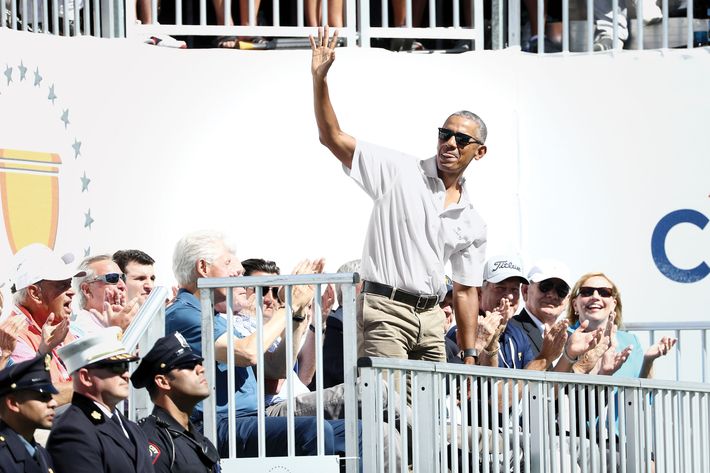
Obama’s relationship with his own party is complicated: He is singularly beloved but also increasingly blamed for three developments that in retrospect look like significant, but avoidable, mistakes. All three are directly related to his preference for avoiding the political fray. First, in the immediate aftermath of the 2008 economic crash, Republicans won the messaging game, branding Democrats as the party of technocratic elitism and themselves as the economic populists. Second, he didn’t speak more forcefully in the moment about Russia’s attempts to sway the 2016 election. And third, he presided over a significant hollowing out of the party’s down-ballot standing during his tenure. In the days before Trump’s inauguration, Obama shouldered a piece of the blame for his party’s sad shape: “I take some responsibility on that,” he told George Stephanopoulos. “I couldn’t be both chief organizer of the Democratic Party and function as commander-in-chief and president of the United States. We did not begin what I think needs to happen over the long haul, and that is rebuild the Democratic Party at the ground level.” The National Democratic Redistricting Committee, which Obama helped Holder launch, is his primary attempt to do it.
The NDRC is Holder’s baby, but it’s given Obama a tidy way to occasionally step back into politics with an eye to long-term reform rather than short-term partisan gain. The pair sat down in February to extensively discuss the group’s 2018 targets and strategy before Holder announced them, and when Obama campaigned in Virginia’s gubernatorial race last year, he made a point of specifically mentioning redistricting on the stump.
Still, much of the liberal angst over Obama’s post-presidential role focuses on what he might do to help direct a historic win in this year’s midterms. He has committed in conversations with party leaders to raising money and campaigning for candidates up and down the ballot. According to those familiar with the conversations, his reemergence on the campaign trail will come late — perhaps in September — and he has told allies he is very unlikely to wade into competitive primary fights, even when former staffers are running. (More than 60 have declared their candidacies.) He often reminds those asking for his help that he believes he needs to create the space for new leaders to emerge.
After helping get his former Labor secretary Tom Perez elected to the DNC chairmanship early in 2017, Obama has had minimal involvement with the party’s central committee. The two speak fewer than once per month now, according to people close to both of them, and Obama has not actively monitored the group’s reform efforts after 2016’s bruising primary fight, which has turned into an identity crisis for the party. He only agreed to hold three fund-raisers for Democratic groups this summer after fielding months of requests, and aside from one event for Missouri senator Claire McCaskill, he has yet to raise money for any individual candidates or party super-PACs.
Party organizers have begun complaining that his focus on his foundation is sapping the coffers they’re desperately trying to tap. Whereas Obama has found significant fund-raising success in Silicon Valley, for example, the rest of the party is still struggling there. “The donor universe that we operate in is limited. It’s the same usual suspects that everyone is going to, whether it’s the House, or the Senate, or these new outside groups, or super-PACs,” says one top party fund-raiser who has been told by multiple potential donors that they’ve already emptied their 2018 checkbooks for the foundation. “And most, if not all, of them were previously Obama supporters, and we’re counting on them for something more important right now than a library in Chicago. Nobody expects him to be out there bashing Trump or being on the campaign trail every day. But to be sucking up resources now is just tone-deaf, and self-serving.”
To the former president’s loyalists, it’s all evidence that some Democrats haven’t come to grips with his role as he has defined it. “I don’t think we should be relying on him as a crutch to deal with Trump,” says Colorado senator Michael Bennet. “We need to step up and deal with Trump.”
Nearly 50 Democrats have, at some point, thought about running for president in 2020, figuring Trump will either be easily beaten or, roughly, “if he can do it, so can I.” And so while Obama is ensuring he’s not his party’s main character in 2018’s fight, he has quietly offered himself up as a consultant of sorts to the ambitious young Democrats who will define the future of the party.
The meetings, which often take place at the sofa and coffee table in Obama’s office, last as long as an hour. Without explicitly diving into his party’s internal disagreements about how far left to tack, and with what emphasis, he takes their questions and talks philosophically about what is needed in the current political moment. He is closely reading contemporary conservative criticism, in particular the work of The Atlantic’s Conor Friedersdorf and academic Patrick Deneen, whose most recent book is Why Liberalism Failed. He frequently worries about the gulf between Fox News and the Times, NPR, and MSNBC, occasionally citing a rand Corporation study on the shrinking role of facts in American life. With measured language, he has occasionally mused about the left’s need to mix idealism with practicality, without falling too hard on one side of the spectrum or losing sight of everyday Americans’ financial reality.
“What we need President Obama’s help with is creating a contrasting economic message heading into 2020,” says Connecticut senator Chris Murphy. “What Obama was brilliant at in 2012 was making that election with Romney all about an economic contrast, making Romney be the candidate of the economic elites and making Obama be the candidate of Ohio, Wisconsin, and Pennsylvania. That’s a contrast that we didn’t make effectively in 2016 and need to make more effectively in 2020.”
After Bill Clinton left office, he clearly enjoyed the power he retained within the party, involving himself in large and small decisions and flexing his influence. Here, too, Obama has assumed a more passive role, positioning himself as a detached observer who might have some useful advice to bestow. As he was leaving office, he publicly identified a handful of rising liberals who he believes represent the party’s future, including Kaine, Bennet, California senator Kamala Harris, South Bend mayor Pete Buttigieg, and former Missouri secretary of state Jason Kander. He’s talked to all of them but Harris in recent months, and has also met with others hoping to lead the party in the near term. This includes both Sanders and Massachusetts senator Elizabeth Warren, potential progressive presidential front-runners who have had difficult relationships with Obama. (They both criticized his paid-speaking tour early in his post-presidency.) Other possible 2020 contenders who’ve met with Obama include New Jersey senator Cory Booker, Los Angeles mayor Eric Garcetti, and former New Orleans mayor Mitch Landrieu.
When asked about the presidential election, Obama talks about his own experience. He tells his visitors it took him about a year of campaigning to figure out how to effectively run for president, and he warns them about the toll a presidential race takes on families and personal lives. He says there’s no half-running: They have to fully want it, and they have to know exactly why they’re running. He directs them to his 2008 campaign manager, David Plouffe, for mechanical and operational advice. And he makes it clear that he has no intention of endorsing early in the 2020 primary.
Still, even this is complicated territory for the former president, who has at least three close associates considering runs. His former vice-president, Joe Biden, is near the top in early opinion polling of the potential field, and Biden’s spent the past two years traveling widely on behalf of local candidates who could prove useful allies in an eventual campaign. Holder has also started publicly musing about running. Yet it’s Deval Patrick, the former Massachusetts governor, whose exploration has stirred the most interest in influential corners of Obama’s world, where he is sometimes thought of as the potential contender likeliest to re-create Obama’s coalition of voters. The pair never overlapped at Harvard Law School, but they met through that connection, and they went out of their way to support each other’s ascent as two of the nation’s most promising young African-American politicians in the George W. Bush era. The former president and the former governor, now an Obama Foundation board member, have spoken multiple times in recent months, just as Patrick’s curiosity about a nationwide run has become common knowledge in political circles.
Obama has said nothing about his three friends in public, but some of his top allies have sent signals about their own preferences. In May 2017, Jarrett was invited to join Jeb Bush on a panel at a hedge-fund conference in Las Vegas hosted by Robert Wolf, a close Obama friend and former bank executive. Before they got onstage, Wolf warned that he’d ask them whom Democrats would nominate in 2020. When the time came, Bush named Biden, who was also at the conference. Jarrett surprised the crowd by predicting her party would nominate Patrick.
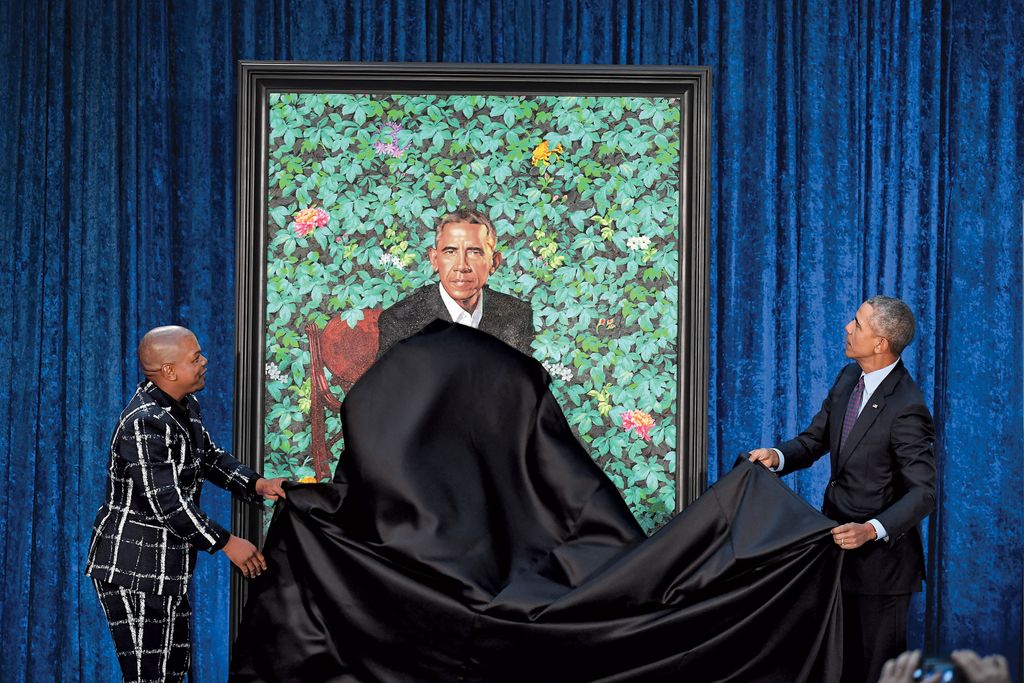
On the gray morning of February 12, Trump’s White House was entering the stage of the Rob Porter scandal where the president was defending the just-fired senior aide accused of abusing two ex-wives. Later that day, Trump would introduce a budget blueprint that included a nearly one-third reduction of State Department spending and a one-quarter cut for the EPA.
At the National Portrait Gallery, Obama stared out at a room full of friends, political allies, and former staffers. Behind him onstage was a pair of portraits of him and Michelle, newly unveiled to wide, if wistful, smiles. “Well, good morning, everybody. It’s wonderful to see you all,” he said, looking back at Kehinde Wiley’s painting. “How about that? Pretty sharp.”
Swaths of Puerto Rico were still blacked out, and at the Winter Olympics in South Korea, Vice-President Mike Pence was inflaming tensions with North Korea. Within a few hours, the Senate would debate immigration after months of fury in Washington. The attorney general would soon praise a group convened by the National Sheriff’s Association for upholding “a critical part of the Anglo-American heritage of law enforcement.” Trump would later sit for lunch with his Education secretary, Betsy DeVos, perhaps as dedicated as anyone in his Cabinet to unwinding the preceding administration’s work.
Looking over the crowd, Obama saw people who had stood with him for eight years and were now, largely, waging the resistance. Many were helping to run issue-advocacy groups aiming to protect his signature achievements, others jumping back into policy-making — some even as the kind of cable-news talking heads Obama couldn’t stand.
“I want to thank everybody who is here,” Obama continued. “It means so much to us, and I hope you’re aware of that. We miss you guys. And — ”
The crowd broke out into uncomfortable giggles, then laughter and applause: He misses us? Does he realize how much we miss him?
Obama looked up, appearing slightly startled by the reaction. The laughter continued, and, clearly stifling a smile, he decided to look down at the lectern for just a beat. Then, sounding serious and louder than before, he repeated himself. “We miss you guys.” He seemed determined not to acknowledge just how much of his isolation is self-imposed.
*This article appears in the June 25, 2018, issue of New York Magazine. Subscribe Now!
